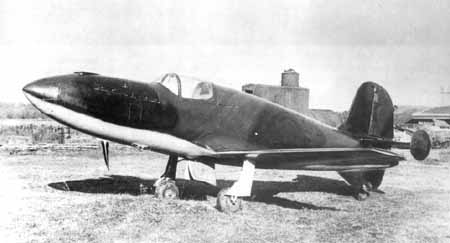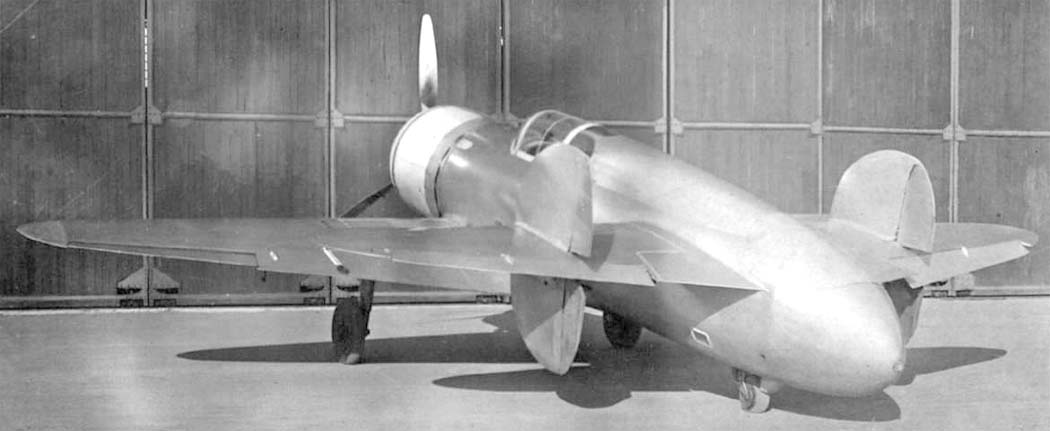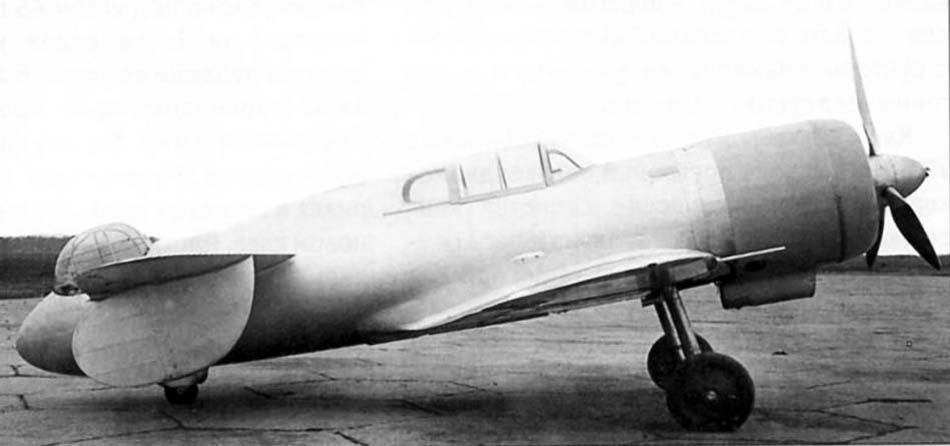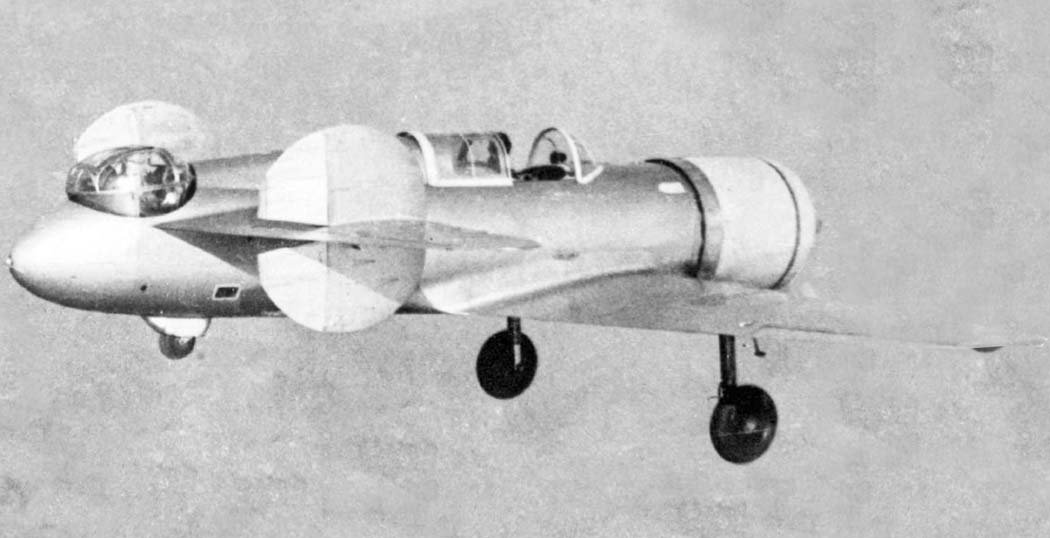With my usual accuracy and knowlegde I will deal this time with the projects and prototipes of the CCCP.


With my usual accuracy and knowlegde I will deal this time with the projects and prototipes of the CCCP.

[FONT=Times New Roman][SIZE=2][LEFT][FONT=Verdana]Bereznyak-Isayev BI
[/LEFT]
[/FONT][LEFT]Purpose: Experimental rocket-engined
interceptor-fighter.[/LEFT]
[LEFT]Design Bureau: Designers Aleksandr
Yakovlevich Bereznyak and Aleksei
Mikhailovich Isayev, working at OKB of
Bolkhovitinov, later managed by CAHI
(TsAGI)[/LEFT]
[/SIZE][/FONT][LEFT]
In 1939 Bereznyak was an observer at the static tests of the first reliable rocket engine developed by Leonid Stepanovich Dushkin.
In early 1940 he watched flight tests of the primitive RP-318 (see later under Korolyev). He discussed rocket aircraft with Isayev, who had been a Dushkin engineer involved with the RP-318. In late May 1941 they decided to propose a high-speed rocket-engined fighter.
They put the suggestion to Prof Bolkhovitinov .After discussion with all interested parties Bolkhovitinov sent a letter to GUAP (chief administration of aviation industry) on 9th July 1941 putting forward a detailed proposal. Soon a reply came from the Kremlin.
The principals were called to GUAP before Shakhurin and A S Yakovlev, and within a week there was a full go-ahead. The order was for five prototypes, with the time to first flight cut from the suggested three months to a mere 35 days.
A complete Bolkhovitinov team were confined to the OKB for 40 days, working three shifts around the clock. Tunnel testing was done at CAHI, supervised by G S Byushgens.
The first (unpowered) flight article was built without many drawings, dimensions being drawn directly on the materials and on templates. B M Kudrin made the first flight on 10th September 1941, the tug being a Pe-2. All necessary data were obtained in 15 flights. On 16th October the OKB and factory was evacuated to a half-built shed outside Sverdlovsk.

The first (experimental) D-1A engine was installed in late January 1942, but exploded during testing on 20th February, injuring Kudrin (sent to hospital in Moscow) and a technician.
The replacement pilot was Capt G Ya Bakhshivandzhi. He was in the cockpit on the first tied-down firing on 27th April 1942.
On 15th May 1942 he made the world’s first flight of a fully engineered rocket interceptor,still fitted with skis. By March 1943 seven BI prototypes had been constructed, but the flying was entirely in towed or gliding flight because of serious problems caused by explosions and acid leaks.
Powered flying did not resume until
February 1943. By this time Kudrin had returned to flight status, and was assigned one of the Bis. On powered flight No 6 on 21st March 1943 a height of 3km (9,843ft) was reached in 30 seconds. On powered flight No7, with aircraft No 3, on 27th March, Bakhshivandzhi made a run at sustained full power; the aircraft suddenly pitched over and[/LEFT]
dived into the ground.
Tunnel testing later showed that at about 900km/h the BI would develop a nose-down pitching moment which could not be held by the pilot.
This terminated the delayed plan to build a production series of 50 slightly improved aircraft,
but testing of the prototypes continued. Until the end of the War these tested various later Dushkin engines, some with large thrust chambers for take-off and combat and small chambers to prolong the very short cruise endurance (which was the factor resulting in progressive waning of interest).
Other testing attempted to perfect a sealed pressurized cockpit. To extend duration significantly BI No 6 was fitted with a Merkulov DM-4 ramjet on each wingtip. These were fired during test in the CAHI T-101 wind tunnel, but not in flight.
By 1944 the urgency had departed from the programme, and the remaining BI Nol (some were scrapped following acid corrosion) were used as basic research aircraft. BI No7 was modified with revised wing-root fairings and stronger engine cowl panels, but at high speed tailplane flutter was experienced. BI No 5s (on skis) and BI No 6 (on wheels) were
modified and subjected to investigative gliding tests, initially towed by a B-25J.
Looks like somthing from Luft46…
I guess people focus too much on the Luftwaffe. (myself included)
Another thing, how come people say that the first and the only rocket intercepter to be built in wwii was the famous Komet?
The B-1 wasn’t fully succesfull.It never was in serial production.
The tragedy during testing ( the highly-experienced Capt G Ya Bakhshivandzhi has perished ) and many lack of rocket engine ( short working time ,great danger for pilot durign speed landing and other pure technical troubles make it DAMN hard in service in the regular aviation.
Beside in the 1942-43 the science know too less about Subsonic/supersonic regimes of fly. Many pilots died during testing the subsonic aircraft.
As i know in the 1944 the program of Soviet Rocket interceptor B-1 has been finally frozen- it was clear that Rocket engine can’t be effectively used in field-based aircraft.
The needs to carry on the board the VERY chemicaly DANGER oxidizing agent ( usialy the nitric acid) make the pilot work very danger.
In the 1944 it was already clear - the future of aviation belong to the Jet engines.Germans already started the mass production of Me-262 that was almost as speedy as the rocket interceptors , but lose most of rocket engines technical lacks.
Another thing, how come people say that the first and the only rocket intercepter to be built in wwii was the famous Komet?
The komet was tested first as a glider, the BI received his rocket engined some months earlier than the german aircraft, aniway the Komet did enter service and the BI did not.
There is plenty of russian experimental and interesting design, ill post more soon.
Grushin shturmovik
Purpose:
[LEFT]To devise an improved configuration for a tactical attack aircraft.
[LEFT]Design Bureau: [/LEFT]
[/LEFT]
[LEFT]Moscow Aviation Institute, designer Pyotr Grushin.
[LEFT]Born in 1906, Grushin worked on various aircraft at MAI, as well an remarkable steam engine tested in a U-2 (Po-2). [/LEFT]
[LEFT]In 1935 he began scheming a tandem-wing aircraft, thinking this could form the basis of an attack aircraft with a rear gun turret. The single example of the Sh-Tandem (Shturmovik-Tandem) was constructed in the Institute’s production training school. It was exhaustively tested by Stefanovskii from 5th December 1937.[/LEFT]
[LEFT]Once the dangerously inadequate directional (yaw) stability had been corrected, by adding fins and rudders above the tailplcine, the aircraft flew well. [/LEFT]
[LEFT]Eventually it was judged to be unreliable and not really needed, but a derivate with armour, an M-82 engine and a cannon in the turret might have proved very useful.[/LEFT]
[LEFT][SIZE=1][SIZE=2]The key feature of this aircraft was that it had a main wing and a rear wing with 45 per cent as much area, both having R-l 1 aerofoil profile. After experimenting with elevens the control surfaces on the rear wing were linked to move in unison as elevators, all lateral control being by the ailerons on the main wing.[/LEFT]
[LEFT]Fins and rudders were fitted at 50 per cent of the semi-span on the rear wing, initially on the underside only in order to leave a clear 250° arc of fire for the electrically driven turret with a 7,62mm ShKAS. Four more ShKAS were to be fixed firing ahead from the main wing, but these cannot cant be seen in photographs. An internal bay housed a 300 kg bombload.[/LEFT]
[LEFT] [/LEFT]
[/LEFT]
[LEFT]The engine was an M-87 (derived from the Gnome-Rhone K14) radial rated at 930hp.
The tailwheel was fixed but the neat main units had single legs and retracted into the wing. The airframe was constructed mainly of wood, with skins of delta bakelite-impregnated veneer. Other features included a three-blade variable-pitch propeller.[/LEFT]
[LEFT] [/LEFT]
[/LEFT]
[LEFT]Despite its extraordinary appearance this aircraft was clearly basically successful.
Whether a developed version could have done better than the Ilyushin Shturmovik is debatable.[/LEFT]
[LEFT]Wingspan of the Grushin Sh was 11 meters, lenght 8,5 and it have a maximum speed of 410 km/h[/LEFT]
[/SIZE][/SIZE]
[/LEFT]
More photos of the Grushin Sh also know as “Grushin Tandem”:



the thing looks like a biplane from the front:D
Hey, Hans look at the red piece of schise over htere! its a bloddy biplane!
Oh, wait…WTH? that bloddy turret… Arrrgh!
:D:D:D
So many the bloody brilliant ideas!!! Sadly, our grandpa’s meet The War with I-16 called “burro”.
Despite its extraordinary appearance thisaircraft was clearly basically successful
Whether a developed version could have done better than the Ilyushin Shturmovik is debatable
This project NEVER was succesfull…
Even the in first look anybody should note - this aircraft will suffer from lack of lengthwise stability in fly.Becouse of TOO rear mass-centre.
Besides, the rear cocpite creats the additional resistence , so aircraft losed about 34 km/h in speed.
http://www.airwar.ru/enc/aww2/shtandem.html
Exactly that was the reason , why this aircraft hasn’t been puted at the mass production.
Unique for its time- it was rather sensless and danger in service.
It wasn’t match for Il-2.
Thank to god , it was just I-16, slow but very maneuvrable fighter.If the Grushin Tandem was was in service- many of our grandpa’s simly crushed during landing or taking off.
I suppose that Yefim Gordom in Soviet X-planes ( my main source for this topic) means that the configuration was succesful not the aircraft itself.
So many the bloody brilliant ideas!!! Sadly, our grandpa’s meet The War with I-16 called “burro”.
Burro wich means “donkey” in spanish.
Unique for its time- it was rather sensless and danger in service.
It wasn’t match for Il-2.
The first single seat Il-2s without rear defense fell like flies to Bf-109s despite its heavy armor, the Grushin Sh in other hand had a gunner from the start, in that aspect it could ; I say again could be more “survivor” in the battlefield.
Tomashevich Pegas:
This was a real oddity. Tomashevich was part of the team wich designed the I-180 series, given the failure of that fighter Tomashevich and other were imprisoned and evacuated to Siberia in 1942.

In there Tomashevich ( teorically under detention) designed a attack aircraft wich would to be construted in a very short time and with simple materials by non-skilled labour hands.
Its target was to replace the Polikarpov U-2 in night bombing and harrasing duties, also it could carry a heavy punch in the way of large caliber cannons for the anti armor role.

His main drawback was that it is really underpowered ( 2 x 150 hp five cilinder radials) and that gave low velocity, to counter this the pilot was completely protected from machinegun fire in an armored “bathhub”.
Low quality construction plywood, roof cover tan, pine wood, soft steel (joints and armour), angular shape made ‘111’ very easy to built even for least skilled workers. Duralumin was used only on engines cowling. Pilot cockpit was protected against 20 mm shells, windshield - against 7.62mm ammo. Main external fuel tanks were dropable, with internal armored tanks providing fuel for 30min flight. Pilot cockpit construction provided very good down-forward sight, special in the No04 configuration.

ITP
Istribitel Tizholi Pushechni
In winter 1940 Polikarpov began to work on a heavy armed fighter.
The designation ITP means heavy cannon fighter.
The plan was to create an aircraft for bomber escort and ground
attack. The armament should consist of a 37mm Sh-37
with 50 rounds and two synchronized 20mm Shwak 200 rounds each.
The ITP M-1
In October 1941 the first prototype, the M-1, was ready.
Powered by a M-105P with 1400 hp. The evacuation of the OKB
delayed the maiden flight until the 23 February 1942.
The test flights couldn’t been made til end, because of the
unreliability of the engine.
In late 1942 the machine was brought back to Moscow.
The engine was replaced by a M-107PA with 1650hp and the
Sh-37 by a third Shwak. After the static tests, ordered by
the NKAP (National Commisariat of aviation industery),
the M-1 was unable to fly.
The ITP M-2
The second prototype, the M-2, was build in Novosibirsk.
It was powered by a AM-37 engine and armed with 3 Shwak.
In December 1942 the M2 was also brought to Moscow, where
the engine was replaced for a AM-39 with 1800hp.
The maiden flight of the M-2 on the 23 November 1943
was very promising, the high speed was by 650km/h at 2500m.
But the project was stopped, because the plants started the
production of fighters with simular preformance.
The first attached photo shows the engine of the M-1
and the second shows the M-1 during the testflights
This was fast, thanks for the information.
In the 1930’s the VVS thought about a massproduced, multifunctional aircraft.
In 1936 the project “Ivanov” was started. The main task was to create an aircraft for
the role as ground attack aircraft, reconnaissance aircraft, light bomber and
bomber escort. The main attribute of the Ivanov should be reliability and
it should be easy to maintenance.
I’ll write a seperate post to each aircraft later.
To many task for a single aircraft usually leds to failure like the Me-210, nice squematics.
[b][u]The Grigorovich I-z.
[/u][/b]Information about the little fighter wich is mostly related with the APK-4 gun, extracted from “Soviet X Planes” and , by the way APK was for Avtomateshko Pushka Kurchevski, meaning Kurchevski automatic cannon.
By the end of the 1920s design bureaux were receiving contracts for experimental fighters designed to be armed with such weapons. In late 1929 Grigorovich was sent to Central Construction Bureau 7, which was really Hangar 7 at Factory 39, an OGPU secure prison for designers. Here he led the design of the Z, a secret monoplane to be armed with two 76.2mm (Sin) APK-4 guns. To speed construction the powerplant group and forward fuselage of the first prototype were the same as those of the Polikarpov I-5, which was also built in Hangar 7.

The complete aircraft, called I-Z (Fighter Z) was flown by Benedikt
Bukhgol’ts in (it is believed) early May 1931. It was inspected by Stalin, Voroshilov, Molotov and others on 6th July 1931. Subsequently a small series of 21 production I-Z fighters were produced at GAZ No 39. These were still regarded as experimental. In February/March 1933 aircraft No 39009 was placed on a high platform and used for firing trials, and in September 1933 No 39010 underwent NIl-WS testing. Two of these aircraft were later used in Zveno trials, as described under Vakhmistrov. In 1934-35 Factory No 135 at
Kharkov built a further 72, with modifications, designated IP-1. These saw only limited use, partly because of difficult spin recovery.
At this time monoplanes were still structurally difficult, and the wing, though of torch-welded stainless (Enerzh-6) lattice construction, still needed underwing bracing to the fixed landing gears. Apart from the semimonocoque rear fuselage, the covering of the whole airframe was fabric. The prototype hada Bristol Jupiter, in a helmeted cowling, while the first production batch had the same 480hp engine built under licence as the M-22
and cowled in a Townend ring. The second batch, from Kharkov, had the 700hp M-25 (Wright Cyclone). The main landing gears variously had spatted wheels, plain wheels or skis.

interesting pictures
Tupolev ANT-23.
other project using the 76mm guns.
Of unconventional design, it employed a tandem fore-and-aft engine arrangement and twin tailbooms embodying recoilless 76mm Kurchevski APK-4 weapons as integral, but non-load-carrying, structural components, the gun gases being discharged from their tails. First flown in late December 1931. Flight testing continued and it was found the aircraft was overweight and suffered substantially higher drag than had been calculated. On a May 19, 1932 gun test-flight, the port gun exploded, damaging the tail boom which collapsed on touchdown. The plane was repaired and a system to eject the rear propeller to give pilot a safe way to get out was installed. However the project was discontinued in early 1933.
Tupolez ANT-23 designated I-12 “Baumanski Komsomoletz”

